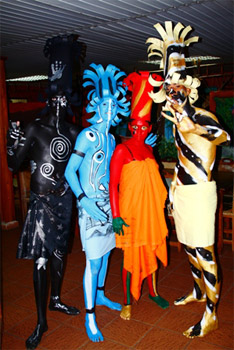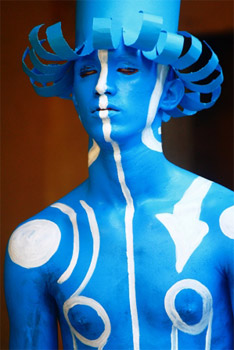Living Statues in Santiago de Cuba (II)
An interview with the creator of the living statues group “Ojos,” Alcides Carlos “Titi” Gonzalez

HAVANA TIMES — Body paint is an artistic substance applied to the skin and is considered one of the earliest forms of artistic expression used by our ancestors. Almost all tribal societies practiced body painting, making their colors from coal, ashes, juices and fruit seeds, and animal blood. This perhaps served to impress their enemies as war paint or to display their status in a tribe or as camouflage when hunting.
This makeup technique reappeared in the West in the late twentieth century as transitory art in which drawings were created on models. Body painting is again being practiced today in modern societies, where it has the objective of being entertaining and decorative. Its spectacular character makes it a highly valued activity.
HT: Why did you take an interest in body painting even though you’re not a visual artist?
AG: Generally, almost all artists have — along with their specialty — some other vocation for art. This concern, which is the so-called “Ingres’ violin,” is suffered by almost everyone. There are artists who feel some frustration for not being musicians, and actors who feel some frustration for not being artists – which is my case. Being an actor, I’ve always been a big fan of the arts and music. That’s how I came up with the idea of doing something with this through the living statues and body painting.
HT: When and how did you create this project?
AG: I created the project about four years ago. It had its roots in a concert here, at the AHS (Asociacion Hermanos Saiz); so I had this idea kicking around in me for a long time afterwards. Therefore I finally decided to support the concert with these performances by the living statues.

I should explain that prior to this the dancer and choreographer Yanoski Suarez had been working with living statues, but her statues danced and then went back to being immobile. That was called “Los caminos de Santiago,” a cultural exchange project between young creators from Santiago de Cuba and Santiago de Compostela in Spain.
HT: Why the name “Ojos” (Eyes)?
AG: Because the statues are silhouettes, symbols… and they look, they see. For us it’s primarily an art to be enjoyed by looking at it. It doesn’t try to make you think or reflect; it’s merely to be observed. It’s for the public to enjoy and be remembered later as something nice or interesting, nothing more. That’s why I gave it that name, “Ojos.”
HT: Where have you performed?
AG: In public venues basically, and at important urban cultural events, not only ones in Santiago but also in other provinces. We have presented at the Romerias de Mayo Festival in Holguin, at the Political Song Festival in Guantanamo, at the Feast of Cubania in Bayamo, as well as in the streets and in scheduled activities like art exhibitions, concerts, etc.
HT: Do you need any official permission to perform in the streets?
AG: No, not at all. Since this is a project of the Asociacion Hermanos Saiz, they have a kind of endorsement to venture out and do public displays without any problems.

HT: And with you being the president of the association in the province, it’s even easier no doubt (laughter).
AG: No, not at all. It would be the same if they were led by any other artist.
HT: Representations of this type of art allow the display of the body. The statues circulate in public places almost entirely nude or with small pieces of fabric shaped like loincloths. Do you think that this clashes with the modesty that prevails in society about people being naked?
AG: No. We’ve been working half-naked for a while; and in the case of the women, their breasts have been exposed. There’s something important when you see a painted body. You’re not looking at a naked body per se, since the paint becomes their clothes. The public reception to this has been very good. There haven’t been any attacks of any kind – not even verbal.
We want a show in which people are fully naked, though I’ve resisted up until now because I think that in all art forms nudity should be justified – be it in the theater, painting, performance, dance or whatever. It shouldn’t be gratuitous provocation, although the perception of society today regarding nudity is very different with respect to the prejudice that we might have found a few years ago.
So we’re planning to do it to see the public’s reaction, though I believe that at this point it will be the same as what we’ve experienced so far, a very good response.
HT: Body painting addresses many themes. But most allude to animals (figures of zebras, cats, birds and fish), camouflage (with the body being integrated into its environment, trees, etc.), and the fantastic (scaled multicolored creatures with wings, antennae or claws). Why did you choose that latter theme?
AG: Again, I repeat, we don’t want people conceptualizing about what they’re seeing. On the contrary, what is done by Teatro Allegro (which has succeeded at interweaving the statues with the theater, which is also what I find very interesting) doesn’t aim at having the audience walking away with any message.

Our intention is for people to come and see, but without conceptualizing. People are busy; they have lots of concerns in their daily lives. So when they come and see these painted statues and stop and say “how nice, how different,” it’s like they’re disconnecting. This is why it’s a theme of fantasy, something different from reality.
HT: Does the use of colors relate to specific symbolic objectives or is it random?
AG: It’s mostly random, but not always. For example we have had shows that have been preconceived, ones like Canto al Africa, where there was a design for each model. In this, the use of color was thought out, and the music too was allegorical, while the statues moved slowly to those sounds.
HT: Is the body painting done by artists?
AG: Artists are sometimes invited to our events, but usually I do the painting. In this way I’ve fulfilled my little desire to be a painter. But yes, we have invited artists, and through them what I have learned above all is the use of certain techniques that can be applied to bodies.
HT: For this type of work, are there certain rules that need to be considered, ones that might involve health risks? Do you pay sufficient attention to this concern?
AG: Yes, of course. We work with acrylics, because we’re unable to get body paste, which is very expensive. It’s sold in hard currency, so we can’t buy it. Our friends can’t even send it to us from overseas.
So when we work with acrylic, we don’t do it often, only twice a month. We apply the acrylic with water and take every precaution to avoid undesirable effects.
We always apply it on perfectly clean and healthy skin, using wash brushes and sponges. We never use inks that are harmful. That’s how we do it.





